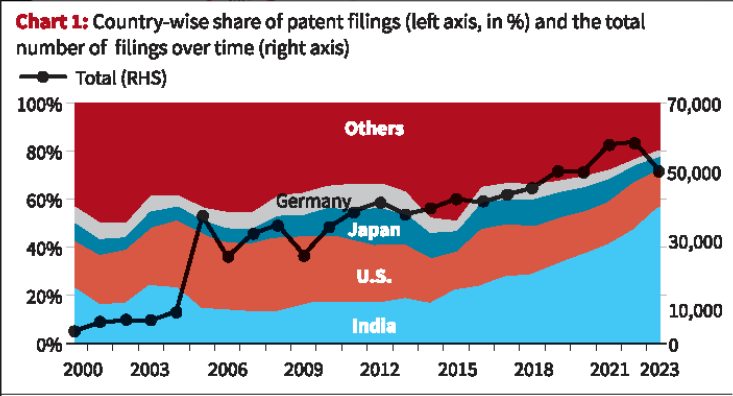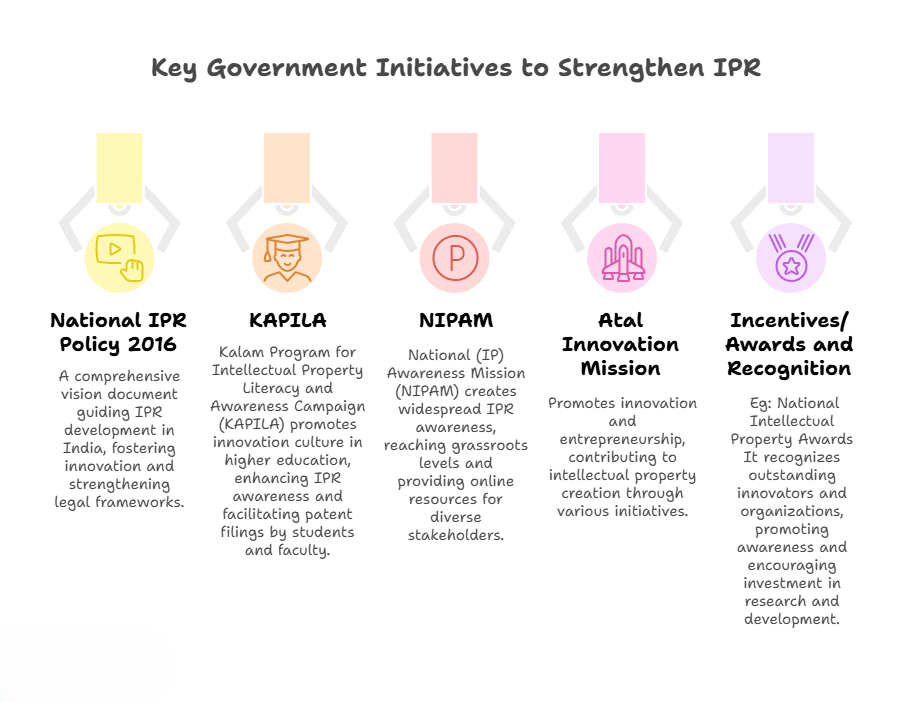Facts for UPSC Mains
Revolutionizing India’s Patent Ecosystem
- 19 Aug 2025
- 8 min read
Why in News?
Innovation lies at the heart of India’s Make in India ambition, and a strong patent ecosystem is pivotal to this journey. As Nobel laureate David Gross noted, India must “discover, invent, and then make.” By deepening R&D and accelerating patent creation, India can evolve from a technology user to a global technology innovator.
What are the Key Trends in India’s Patent Landscape?
- India has achieved a historic milestone by ranking 6th in global patent filings in 2023. In FY24, India granted more than 1 lakh patents, marking a 17-fold increase since 2015.

- Over the last 5 years, India saw a 44% rise in total IP filings, including patents, trademarks, designs, and geographical indications (GI).
- Universities are boosting India’s patent ecosystem through IP cells and legal support units aiding filing, technology transfer, and monetisation.
- For instance, IIT Madras doubled its patents in 2022- 2023.
- In trademarks, India ranked 4th globally in WIPO 2024, with applications rising from around 2 lakh in 2016–17 to around 4.8 lakh in 2023–24, despite a slower growth rate.
What are the Key Challenges in India’s Patent Ecosystem?
India’s patent ecosystem faces persistent challenges, reflected as CLOG in the Patent Pipeline:
- C - Concentrated on Foreign Filings: India's innovation is overshadowed as over 74% of patents in India are granted to foreign entities.
- L - Low R&D Investment: With just 0.67% of GDP spent on R&D, the country lacks the foundational research needed to generate a high volume of quality patents.
- O - Overburdened & Outdated Processes: A critical shortage of skilled examiners and inefficient processes lead to an average patent approval time of 58 months, whereas the same takes 20 months in China and 21 months in US, a significant roadblock for innovators.
- G - Gaps in Enforcement: Gaps in IP protection, slow judicial processes, and growing digital piracy continue to limit the effective safeguarding of creators’ rights in India.
- Also, though India has made significant strides in patent filings, the translation of these patents into large-scale commercialisation remains limited.
What Measures Should be Taken to Transform India’s Patent Ecosystem?
To clear the CLOG, India must implement a strategic plan for REFORM to transform its patent ecosystem.
- R - Regulatory & Legal Reforms: Establish dedicated IP courts for speedy dispute resolution and strengthen penalties for infringement.
- The government must also review outdated laws, such as Section 3(k) of Patents Act, 1970 to encourage the patenting of emerging technologies like AI.
- E - Ecosystem Building: Foster strong partnerships between academia, industry, and government. This will create a supportive environment for innovation hubs and incubators that drive new research and filings.
- F - Fuel R&D Investment: Provide robust tax incentives and venture capital funding to the private sector to increase R&D spending.
- O - Optimize Processes: Modernize the patent office with user-friendly digital portals and leverage AI for prior-art searches. This will help streamline the entire patenting journey, from filing to grant.
- R - Resource Mobilization: Strengthen India’s IP capacity by expanding skilled examiners, upgrading patent offices with modern digital infrastructure, deploying AI-enabled tools for faster scrutiny, and creating dedicated training hubs for continuous upskilling.
- M - Mobilize Global Partnerships: Engage in international collaborations with bodies like World Intellectual Property Organization (WIPO) to facilitate cross-border filings and attract foreign investment, opening the door for global cooperation.
Keywords for Mains
- “India’s Brain is Patented, India’s Heart is Inclusive” – Innovation with inclusivity.
- “Frugal, Flexible, Futuristic” – Jugaad innovation meeting global standards.
- “Demographic Dividend to Innovation Dividend” – Youth-led IP growth.
Conclusion
India's future as a global innovator rests on its ability to overcome deep-seated systemic hurdles. By embracing a comprehensive revitalization strategy, focused on strengthening R&D, streamlining the IP ecosystem, and nurturing a creative talent pool, India can unlock its full potential, transforming into a self-reliant and globally competitive nation.
|
Drishti Mains Question: Despite a significant rise in patent filings in India, the rate of commercialisation of these patents remains low.” Critically analyse the factors responsible for this gap and suggest measures to enhance the commercial impact of India’s intellectual property. |
UPSC Civil Services Examination, Previous Year Questions (PYQs)
Prelims
Q. Consider the following statements: (2019)
- According to the Indian Patents Act, a biological process to create a seed can be patented in India.
- In India, there is no Intellectual Property Appellate Board.
- Plant varieties are not eligible to be patented in India.
Which of the statements given above is/are correct?
(a) 1 and 3 only
(b) 2 and 3 only
(c) 3 only
(d) 1, 2 and 3
Ans: (c)
Q. With reference to the ‘National Intellectual Property Rights Policy’, consider the following statements:(2017)
- It reiterates India’s commitment to the Doha Development Agenda and the TRIPS Agreement.
- Department of Industrial Policy and Promotion is the nodal agency for regulating intellectual property rights in India.
Which of the above statements is/are correct?
(a) 1 only
(b) 2 only
(c) Both 1 and 2
(d) Neither 1 nor 2
Ans: (c)
Mains
Q. In a globalized world, Intellectual Property Rights assume significance and are a source of litigation. Broadly distinguish between the terms—Copyrights, Patents and Trade Secrets. (2014)







